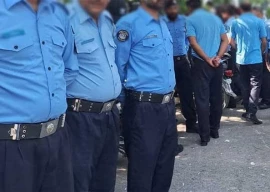
The attack on the Sindh police’s main investigation agency, the Crime Investigation Department (CID) building, near PIDC, on Thursday night killed at least 16 people and injured more than 140. The department is also responsible for anti-terrorism operations, and the attacked building also houses the Anti-Extremism Cell.
Almost expectedly, the Tehreek-i-Taliban Pakistan (TTP) has taken responsibility for the blast.
Azam Tariq, a spokesman for the TTP, claimed responsibility for the attack, which, he said, was in retaliation for US air strikes in the country’s northwestern tribal areas.
“It’s a reaction to the drone strikes and such attacks will continue until drone strikes are stopped,” he told Reuters. It was a coordinated and chillingly efficient strike.
According to Home Minister Zulfiqar Mirza, around five to six people opened fire at the gate of the installation. Moments later, a vehicle packed with explosives forced its way into the premises, and made its way towards the main building, which houses key security officials’ offices.
The vehicle exploded just metres away from the building – setting off an explosion that was heard miles away. Though the skeleton of the building still stands, the facade was blown away by the intensity of the blast.
According to our reporter Hafeez Tunio, police sources said that the vehicle, registered in Peshawar, was carrying around 800 to 1,000 kilogrammes of explosive material.
The powerful explosion left a 10-foot deep and 50-foot wide crater outside the three-storey office building. Walls surrounding the high security zone were destroyed and window panes of nearby buildings were shattered by the impact. The area saw dozens of vehicles destroyed and damaged as rescue workers carried the dead and injured into ambulances.
The tremors of the blast were felt in Defence, II Chundrigar Road, Sharae Faisal and other areas across more than half the city. Roof of houses located just opposite the CID station in Civil Lines colony caved in, leaving several residents, most of whom worked as daily wagers, trapped inside. Houses in nearby Hijrat Colony were also damaged. The debris flung as far as the street leading towards the main gate of the Chief Minister House, which is located just 200 hundred yards away.
Witnesses said that, prior to the blast, a gun fight between heavily armed militants and security forces took place at around 8pm. Gulistan Lala, 60, said there were “terrifying sounds of fire that didn’t seem to come from a Kalashnikov, but something more sophisticated.” Lala said that the firing continued for at least 20 minutes before the explosion took place.
The blast plunged the entire area into darkness as smoke fumes engulfed the air. SSP Fayyaz Khan, whose office is located in the building, had left just before the attack occurred. His room was in flames.
A day earlier, he had announced the nabbing of a wanted Tehrik-i-Taliban Pakistan (TTP) militant. His colleagues SSP Omar Shahid and SSP Chaudhry Aslam had claimed a major breakthrough in busting the Asif Ramzi faction of the Lashkar-i-Jhangvi, and arresting six militants on the same day.
Talking to his superior officer over the phone, Khan said the suicide car bomber came in a white Shehzore truck. The militants first killed the guards posted at the gate and continued firing on the building with sophisticated weapons and also lobbed grenades as the vehicle made its way towards the building.
“When I saw the men, who were at least six in number coming towards the building, I opened fire with my sub machine gun,” said CID sub- inspector, Irfan – who was positioned on the third floor of the building.
However, Irfan says he was outgunned by the militants as they immediately spotted his location and fired bullets towards him. “I’m lucky to be alive and still talking here,” Irfan said in his torn white shalwar kameez stained with blood.
However, the death and destruction are not the only things the authorities have to worry about. Also, a cause of concern was the militants and hardened criminals being held inside the building.
Khan, who was visibly shocked as the bodies of his injured and badly maimed colleagues poured out of the building, gave immediate orders to check each lock up inside.
There was no one inside anymore, Khan was told.
A senior intelligence official told The Express Tribune that the threat of an attack on police and security agencies had been at an all time high for a while now. “The CID was at the forefront of breaking the backs of the militant networks and was an obvious target,” he said.
The official said that the nature of the attack was similar to the Marriott hotel bombing that took place in Islamabad. “I don’t believe that this had anything to do with the arrests that CID made public just 24 hours before this incident,” he said however – adding that it was a sophisticated attack that must have taken days of preparation.
“I can tell you that there were no militants inside the CID centre when the bomber struck. We have cordoned off the area,” said IGP Sindh.
Meanwhile, the injured were moved to hospital wards. “At least 12 people are critically injured and are being operated on,” said Dr Seemi Jamali at the Jinnah Hospital.
Published in The Express Tribune, November 12th, 2010.
COMMENTS (32)
Comments are moderated and generally will be posted if they are on-topic and not abusive.
For more information, please see our Comments FAQ


1672385156-0/Andrew-Tate-(1)1672385156-0-165x106.webp)














A very interesting hypotheses indeed. Since you seem to have done 'own research' please throw some light on,If Pakistan is being 'punished for 'being 'China ally', what is the source of punishment for Afghanistan, Sudan, Yemen and Iraq which are also suffering 'extensive operation' If Taliban does not have the fund, then who is behind this, USA? If Yes, then is US funding the ISAF and Taliban in Afghanistan ,and Pak Army and TTP in Pakistan, and Iraq Government and Iraq Taliban in Iraq? And according to your 'own research' for what purpose? If Taliban is not to be blamed for 'everything', why are they so eager to claim responsibility? Remember video of the New York bomber with Mehsud, released by TTP. Who according to your 'own research' is sheltering the Haqqani network in Waziristan? Or does your research establish that there is no Haqqani network at all?on one side the prices are sky rokect,for example daily nescessities,sugar price is 100 rupees per kg.musharraf said very well ab to pakistan ka khuda he hafiz,this govt will sink the country and will flee from pakistan becharay gareeb starvation sa mar jaen ga.